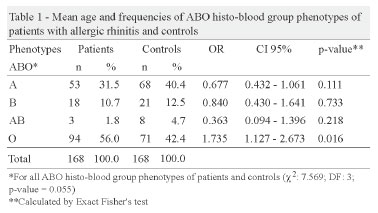OBJECTIVE: The aim of this study was to verify if ABO phenotypes are associated with allergic rhinitis. METHODS: 168 patients with allergic rhinitis and 168 control individuals from the same geographical region and paired by gender and age were enrolled in the study. ABO phenotypes were identified in red blood cells using the hemagglutination technique. The Fisher exact and chi-squared tests were employed to compare proportions. Statistical significance was set for an alpha error of 5% (p-value < 0.05). RESULTS: The overall differences in the frequencies of the ABO phenotypes of patients and controls were marginal (χ2: 7.569; degrees of freedom (DF): 3; p-value = 0.055) however the O blood group was associated with allergic rhinitis (χ2: 5.764; DF: 1; p-value = 0.016; OR: 1.735; CI 95%: 1.127-2.673). The differences in the frequencies of the O phenotype in patients and controls were statistically different for men (χ2: 8.520; DF: 1; p-value = 0.003) but not for women (χ2: 0.6375; DF: 1; p-value = 0.4246). The A phenotype was associated with protection (OR: 0.4385; CI 95%: 0.2043-0.9415; p-value = 0.049) and the O phenotype was associated with susceptibility (OR = 2.789; CI 95%: 1.385-5.616; p-value = 0.005) to allergic rhinitis only for men. CONCLUSION: The O blood group phenotype is associated with allergic rhinitis in male but not in female patients.
Rhinitis, allergic, seasonal; Blood group antigens; ABO blood-group system; Respiratory hypersensitivity; Asthma


